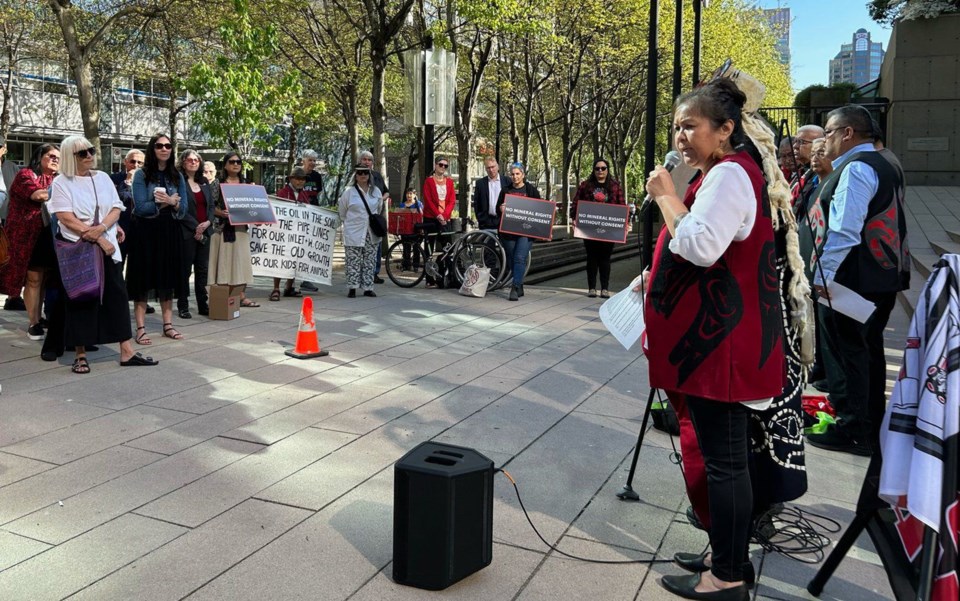Reconciliation isn’t the only thing threatened when mining exploration companies fail to get consent from Indigenous nations, says one ethical investor.
Provinces — and the junior mining companies that obtain exploration permits connected to a nation’s ancestral territories — ignore consultation with Indigenous Peoples at their own peril, as the oversight can set the stage for future conflict, court challenges and delays, hampering any future economic development before it begins.
Currently, B.C. grants exploration rights to junior mining companies after they fill out a couple of forms and pay a small fee to stake the land for mining exploration. Jamie Bonham, head of stewardship at NEI Investments, says Indigenous consultation and consent should be part of the process, too.
“It seems pretty clear we need to get this part of it right,” says Bonham. “Without it, we will struggle to see the potential this industry can realize.”
In B.C., the Gitxaała Nation has gone to court to challenge such regulations within the province’s Mineral Tenure Act. The Gitxaała Nation is launching the challenge to protect their territories after a 2015 Yellow Giant Mine tailings breach, in which wastewater flowed into a nearby creek for six weeks. Water samples exceeded health guidelines for arsenic, lead and mercury, among other contaminants. The spill has resulted in $2 million worth of cleanup costs.
Companies that secure mining stakes aren’t required to consult with or receive consent from Indigenous nations to whose territory their permits are connected. When those mining stakes are sold, this can poison the relationship between First Nations and the major player that typically develops a mine.
Mining operations are fundamentally in conflict with B.C.’s Declaration on the Rights of Indigenous Peoples Act, which incorporated the United Nations Declaration on the Rights of Indigenous Peoples (UNDRIP) into B.C. law, Bonham says.
For Bonham, receiving free, prior and informed consent from Indigenous nations to develop a natural resource project offers the industry a more ethical approach that can mitigate conflict between nations and mining companies. Without it, conflict arises through the courts, civil disobedience and other direct actions by nations attempting to stop development they never agreed to in the first place. In 2014, for example, a group of Tahltan First Nation elders blocked access to Red Chris Copper and Gold Mine in B.C. over fears it would threaten salmon spawning lakes. The Gitxaała challenge is just the latest of such conflicts.
The issue of free, prior and informed consent — one of the central tenets of UNDRIP — is vital to address as Canada expands mining development under its Critical Minerals Strategy, which will unearth key materials required for the energy transition. Keeping on with business as usual, just harder and faster, won’t make the consultation problem disappear, Bonham says.
“So we do need a fundamentally different approach, and I think maybe sometimes you have to go slow, at first, to go faster,” Bonham says. Instead, Bonham thinks consent should be given at the exploration phase to create a strong foundation that doesn’t sprout conflict down the line for a project.
In Ontario, the issue has already arisen, says Anna Baggio, conservation director for the environmental non-profit Wildlands League. Last year, Barrick Gold Corp. launched a $100-million lawsuit against two junior mining companies from which it had bought mining claims. Barrick, the major player in the mining world, abides by free, prior and informed consent, but the junior exploration companies did not. The junior companies later sold mining claims Grassy Narrows First Nation did not agree with, Baggio explains.
Junior companies that seek nations’ consent for mining claims offer a “value-added” deal, Bonham says. It brings a level of certainty to the project for everyone by building a solid foundation with local communities.
“Enough companies have been burned now by buying projects that had a lot of problems with them that they're gonna be looking for ones that don't,” Bonham says.
For Lawrence Martin — interim director of land and resources at Mushkegowuk Council, a tribal council of eight nations in northwestern Ontario upriver from the Ring of Fire — the state of mining in the province is a “scary place to be at the moment.”
Ontario encourages companies to consult with Indigenous nations for mining exploration, but the province does not have a UNDRIP law, and consent is not yet in the legislative language, Baggio says. So many permits flow in every day that Martin’s team has a dedicated staff member to track all of them across the tribal council’s territories.
“It's not an easy job to track them all down and get in touch with them and contact the community and help them respond,” Martin says.
The underresourced and understaffed tribal council is struggling to catch up with an exploration boom as the province hurtles towards development in the Ring of Fire, a region at the centre of Ontario’s critical mineral plans, Martin says.
For Bonham, the risks for industry in the Ring of Fire are only magnified given the significance of what needs to be built, which includes a highway through carbon-rich peatlands. Dozens of junior and intermediate mining companies are also currently in the exploration phase of developing projects in the region.
“For the size of the investment, it would seem even more important to get the alignment with UNDRIP right, lest uncertainty on this issue puts the greater investment at risk.”



